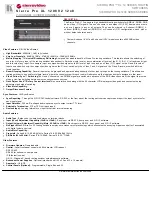
Version
Description
9.2(1.0)
Introduced on the Z9500.
8.3.19.0
Introduced on the S4820T.
8.3.11.1
Introduced on the Z9000.
8.3.7.0
Introduced on the S4810.
7.8.1.0
Added support for Multi-Process OSPF.
7.6.1.0
Introduced on the S-Series.
7.5.1.0
Introduced on the C-Series.
6.1.1.1
Introduced on the E-Series.
Usage
Information
The following describes the
show ip ospf
process-id
database router
command shown in the following example.
Item
Description
LS Age
Displays the LSA age.
Options
Displays the optional capabilities available on router. The
following options can be found in this item:
• TOS-capability or No TOS-capability is displayed
depending on whether the router can support Type of
Service.
• DC or No DC is displayed depending on whether the
originating router can support OSPF over demand
circuits.
• E or No E is displayed on whether the originating router
can accept AS External LSAs.
LS Type
Displays the LSA type.
Link State ID
Displays the Link State ID.
Advertising Router Identifies the router ID of the LSA’s originating router.
LS Seq Number
Displays the link state sequence number. This number
detects duplicate or old LSAs.
Checksum
Displays the Fletcher checksum of an LSA’s complete
contents.
Length
Displays the length in bytes of the LSA.
Number of Links
Displays the number of active links to the type of router
(Area Border Router or AS Boundary Router) listed in the
previous line.
Link connected
to:
Identifies the type of network to which the router is
connected.
(Link ID)
Identifies the link type and address.
1314
Open Shortest Path First (OSPFv2 and OSPFv3)















































